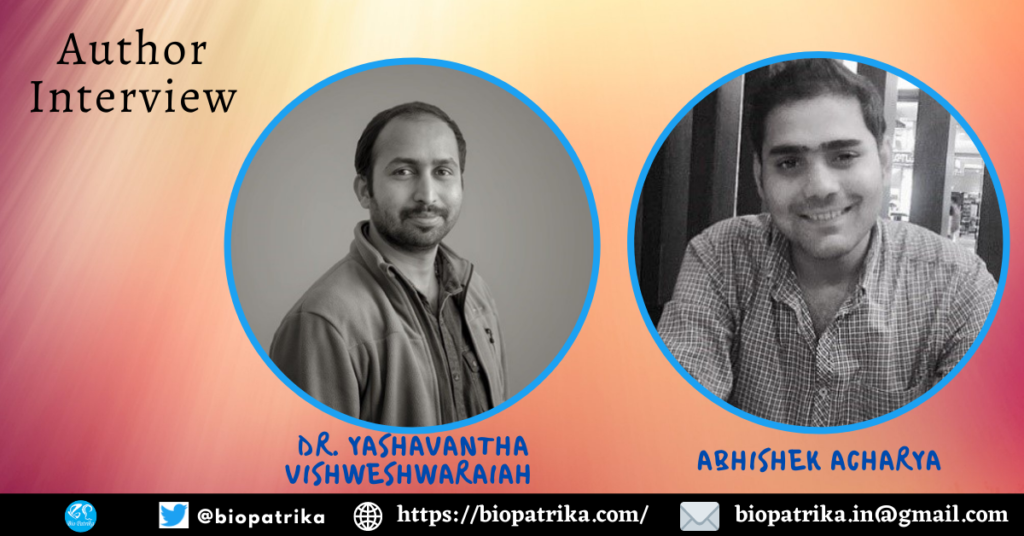About author: Dr. Yashavantha Vishweshwaraiah completed his doctoral thesis under the supervision of Prof. Balaji Prakash at Central Food Technological Research Institute, Mysore. During his doctoral studies, he worked on understanding the structure-function relationship in plant lectins and engineering antibacterial peptide inhibitors. In February 2019, he joined the Dokholyan lab at PennState College of Medicine, PSU, where he works on engineering novel proteins.
A co-first author on this paper, Abhishek Acharya, is currently pursuing his doctoral studies in Prof. Ulrich Kleinekathöfer’s group at Jacobs University Bremen. He obtained his M.Tech. Degree in 2013 from BSBE, IIT Kanpur. Thereafter, he worked on a few projects in Prof. Balaji Prakash’s group, and briefly in a start-up. Initially trained in microbiology and biochemistry, he later transitioned to theoretical modeling and simulations that enable atomic-level insights into the dynamics of proteins and other biomacromolecules. He is interested in the application of computational methods to the study of native proteins and protein engineering for novel applications.
How would you explain your research outcomes to the non-scientific community?
In this work, the objective was to develop safe alternatives to currently used chemical food preservatives. Since preservatives would form part of the daily diet, such molecules must be completely safe for consumption. At the same time, overall stability was also an important consideration for packaging and transport over long distances.
We have designed molecules that possess antibacterial properties with stability at water boiling temperatures and wide range of acidic/alkaline conditions. Nature will always remain the most staggering source of inspiration on the possibilities in peptide and protein design. We started by exploring some peptides from animal and plant sources that had thermostability but very weak antibacterial activity, and the idea was to understand the structure-function relationship for these peptides and rationally design those with better activity.
Another important aspect of our work was an improved understanding of the two different mechanisms that the peptide employs for killing bacteria: first by damaging the protective membrane of the bacterial cell, and second by inhibition of a bacterial enzyme. We have mapped the two mechanisms to distinct parts of the peptide (see figure), which would be advantageous in development of more effective antibacterial.

Our work hints at some of the possibilities in peptide design for food preservation.
How do these findings contribute to your research area?
With an ever-growing population, food safety and sustainability are important issues that need our attention, and these align well with the UN sustainable development goals of reducing hunger, improvement of health and responsible consumption. The ultimate objective is to develop a range of peptide-based food preservatives that are both robust and safe.
Although the present peptides are not currently suitable for industrial application, we did obtain some understanding of the issues pertaining to development of antibacterial molecules for food preservation applications. For instance, in case of antibacterials for clinical applications, some side effects are tolerated, but this is not the case with food applications. Moreover, the molecules must be compatible with other strategies of food preservation such as heating, acidity control etc. Our work hints at some of the possibilities in peptide design for food preservation.
What was the exciting moment during your research?
When we started studying the peptides, the initial designs had no or insignificant microbicidal properties. We had a lot of initial discussion with Prof. Balaji who suggested taking a rational design approach. Once we rationally improved upon the peptide sequence, we noted a remarkable improvement in antibacterial activity, without compromising much on the stability and safety aspects. That hinted to us that the peptides in principle could be significantly redesigned without losing out on the stability. This was an exciting time.
What do you hope to do next?
YV: Currently, I am working on nanoscale computation in biological systems using chemogenetic and optogenetic nano computing agents. I believe that this field will spur the growth of biotechnological applications with wide-ranging impacts.
AA: I am currently studying mechanisms of antibiotic permeation via bacterial porins in Gram-negative pathogens. A related area of interest is the design of nanopores for biosensing applications.
Where do you seek scientific inspiration from?
YV: Mostly my scientific inspiration comes from reading literature. In addition, all my research mentors Dr. Dokholyan, Dr. Balaji Prakash and Dr. Lalitha Gowda will be my constant source of inspiration.
AA: The lives of great scientists and achievers are always inspiring. However, the importance of teachers and mentors in instilling the passion for a subject or area of research is second to none. I read somewhere, “Better than thousand hours of diligent study is one day with a great mentor”. I have been fortunate to work with Prof. Balaji Prakash who over the years has been a supportive mentor and whose inspiring lectures at IITK steered me towards the structural biology of proteins.
How do you intend to help Indian science improve?
YV: Scientific literacy is drastically low in the rural regions. I strongly believe that scientific environment should be created at the grassroots level. I would be more interested to communicate science in the rural region of India, especially with the school kids and younger generation.
AA: I firmly believe that the biggest roadblock to the progress of Indian science is the quality of school education. Especially in science education, good pedagogy makes a world of difference. If possible, I would like to work towards the improvement of science education and training programs for science teachers at the school level.
Reference
Vishweshwaraiah, Y. L.; Acharya, A.; Hegde, V.; Prakash, B. Rational Design of Hyperstable Antibacterial Peptides for Food Preservation. npj Sci Food 2021, 5 (1), 26.
Edited by: Nivedita Kamath
